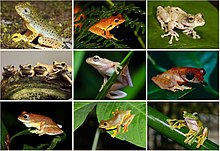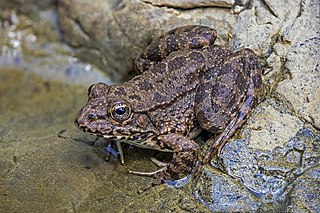
True frogs is the common name for the frog family Ranidae. They have the widest distribution of any frog family. They are abundant throughout most of the world, occurring on all continents except Antarctica. The true frogs are present in North America, northern South America, Europe, Africa, and Asia. The Asian range extends across the East Indies to New Guinea and a single species, the Australian wood frog, has spread into the far north of Australia.

The Rhacophorinae are a subfamily of frogs in the family Rhacophoridae. They range from tropical Africa and Asia to temperate China and Japan.

Rhacophorus is a genus of frogs in the shrub frog family (Rhacophoridae) and the related Hylidae make up the true tree frogs. They are found in India, Japan, China, and Southeast Asia. Over 40 species are currently recognised.

Polypedates is a genus of frogs in the family Rhacophoridae, the shrub frogs and Paleotropic tree frogs. They belong to subfamily Rhacophorinae. Members of this genus are collectively known as whipping frogs. They occur in eastern and southern Asia.

The Malabar gliding frog or Malabar flying frog is a rhacophorid tree frog species found in the Western Ghats of India.

Buergeria is a genus of frogs in the family Rhacophoridae, and the sole genus of subfamily Buergeriinae. They are the sister taxon for all the other rhacophorids. The available firmly supports this position.
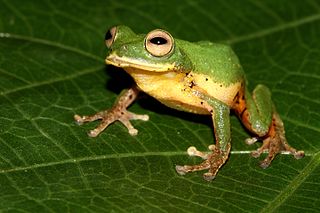
Raorchestes flaviventris is a species of arboreal, nocturnal, frog of the family Rhacophoridae. It is endemic to the Western Ghats, South India. Its common name is yellow-bellied bush frog.
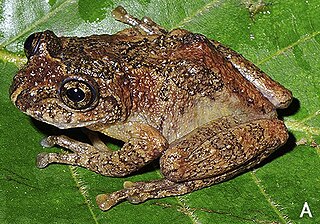
Nasutixalus jerdonii is a species of frog in the family Rhacophoridae. It is found in the northeastern India, in the West Bengal, Nagaland, Manipur, and Meghalaya states. It range might extend into the adjacent Nepal. The specific name jerdonii honours Thomas C. Jerdon, an English herpetologist. Common names Jerdon's bubble-nest frog, Jerdon's tree frog, and Jerdon's bush frog have been coined for this species.

Raorchestes luteolus is a species of frog in the family Rhacophoridae. It is endemic to the Western Ghats, India, where it is only known from the state of Karnataka. Many of the known populations are from the Kodagu district, known also by its anglicised former name of Coorg—hence the common name. It is also known from the Shimoga district in the Sharavathi basin where it was described as a new species, Philautus neelanethrus, but this is now considered to be a junior synonym of Raorchestes luteolus.

Rhacophorus lateralis is a rhacophorid tree frog endemic to the Western Ghats in South India. It has several common names: small tree frog, Boulenger's tree frog, small gliding frog, and winged gliding frog. After its original description in 1883 by George Albert Boulenger, the frog was rediscovered in Coorg in 2000 and has since been found in many parts of the Western Ghats around southern Karnataka and northern Kerala. Along with R. malabaricus, it is one of the few anuran amphibians in India that constructs its nest above the ground using leaves.
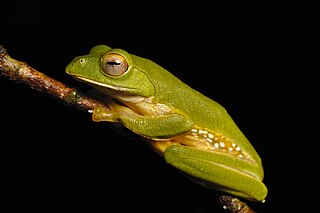
Rhacophorus pseudomalabaricus, also known as Anaimalai flying frog, false Malabar gliding frog, and false Malabar tree frog, is a species of frog in the family Rhacophoridae. It is endemic to the Anaimalai Hills, a part of the southern the Western Ghats in the Tamil Nadu and Kerala states, India.

Raorchestes resplendens, the resplendent shrubfrog, is a critically endangered species of frog belonging to the family Rhacophoridae endemic to the high altitude region around the south Indian peak of Anaimudi. It has extremely short limbs and numerous macroglands and was discovered from the Anamudi summit in the Western Ghats of Kerala, India and is known only from the Eravikulam National Park.
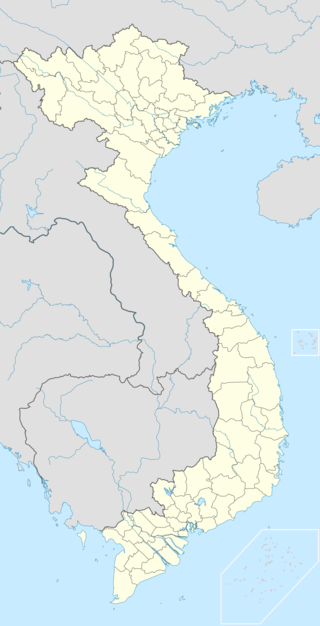
Vampyrius vampyrus is a medium-sized species of flying frogs endemic to Vietnam. It is found in southern Vietnam, and is not known to be found in other places globally. It Is in the kingdom Animalia, phylum Chordata, and class Amphibia. Along with this, it is in the order Anura, family Rhacophoridae, and it is the only member of the genus Vampyrus. It is also known as the vampire tree frog or the vampire flying frog because of the presence of a pair of fang-like hooks in the mouth of the tadpoles.

Raorchestes is a genus of frogs in the subfamily Rhacophorinae that are found in mountainous regions of South Asia, Southeast Asia, and southern China. A recent study places Raorchestes as a sister taxon of Pseudophilautus. Before the description of the genus in 2010, species now in Raorchestes had been assigned to genera Ixalus, Philautus, and Pseudophilautus.

Ghatixalus is a genus of frogs in the family Rhacophoridae, subfamily Rhacophorinae. They are endemic to the Western Ghats of southern India. They are the sister taxon to a larger clade consisting of Chiromantis, Feihyla, Taruga, Polypedates, and Rhacophorus. The name of the genus combines words "Ghats" and "Ixalus". The former refers to the Western Ghats, and the latter to now-abandoned genus name that lives as the suffix in many generic names for rhacophorid frogs.
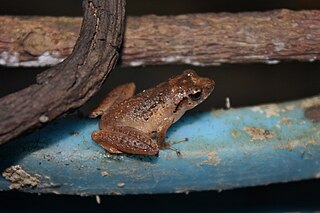
Liuixalus is a small genus of rhacophorid frogs that are distributed in southern China. Some species now in Liuixalus were originally placed in Philautus. It is thought to be the most basal genus in the Rhacophorinae.

Beddomixalus is a monotypic genus of frogs in the family Rhacophoridae. The only described species, Beddomixalus bijui, is endemic to the Western Ghats, India. Its name is derived from a combination of the cognomen of Richard Henry Beddome, in honour of his work on the amphibian diversity of the Western Ghats, as well as Ixalus, which is often used as a suffix for names of rhacophorid genera.

Nasutixalus is a genus of frogs in the family Rhacophoridae. The genus is found in northeastern India and adjacent southeastern Tibet as well as western Yunnan (China); the range might extend into the adjacent Nepal and Myanmar. Common name ridged-nose treefrogs has been coined for this genus.
Annemarie Ohler is an Austrian herpetologist and professor who concentrates on the taxonomy of amphibians. She has 3,602 citations and an h-index of 36.
